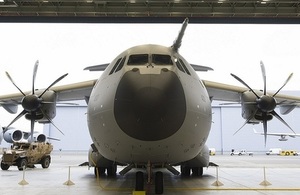New guidance on profits on single source defence contracts published
The Single Source Regulations Office (SSRO) has published new guidance on how companies and the Ministry of Defence should calculate the profit allowed on single source contracts.

A400M at RAF Brize Norton
This follows the announcement by the Secretary of State for Defence last week that, for qualifying contracts signed from 1 April 2016, the baseline profit rate will be 8.95 per cent. The equivalent figure for 2015/16 was 10.60 per cent.
Single source procurement represented around 53 per cent of new MOD contracts in 2014/15 and the MOD spent approximately £8.3 billion on single source contracts that year – a figure which is expected to increase as a result in the additional investment in equipment set out in the November 2015 Strategic Defence and Security Review.
The baseline rate is the starting point for agreeing the profit rate for each contract – it is not the actual profit rate which will be achieved. For each individual contract, adjustments can be made to take account of factors such as risk, performance incentives and capital servicing rates. The new guidance published today sets out the process for calculating those adjustments.
Across the contracts which were examined by the SSRO by March 2016, the average profit rate actually achieved was 12.48 per cent compared with a baseline rate at the time of 10.60 per cent.
Marcine Waterman, Chief Executive of the SSRO, said:
Setting a fair baseline profit rate and being clear about what adjustments can be made is critical to maintaining the credibility of single source procurement. When considering the profit rate, with single source defence contracting there is no procurement risk, there is no credit risk, and it comes with a government backed guarantee.
The 8.95 per cent rate announced by the Secretary of State is a three year rolling average: assessing profits across three years smooths out the impact of any year-to-year changes. Comparable defence companies in Western Europe made an average profit of 7.26 per cent in 2014 and those in North America achieved 8.28 per cent.
When announcing the new rate on 14 March, Michael Fallon, Secretary of State for Defence, said:
Taxpayers can be confident that we are getting better value for money for single source defence contracts as we deliver our £178bn equipment programme. This profit rate provides a fair return to industry while delivering savings that will be reinvested in defence.
The profit rate was calculated using a new methodology, published by the SSRO in January following widespread consultation, which uses the profit rates achieved by a more international and a more appropriate range of companies than before. Previously, only companies headquartered in the UK were considered, including many with little or no similarity in activity to defence contractors. The new guidance published today has been drawn up following a consultation conducted in January and February this year.
Notes
- The baseline profit rate of 8.95 per cent is calculated by taking an average of two rates calculated by the SSRO. The first of these is for ‘develop and make’ type activities and was calculated as 8.77 per cent. This was calculated from the profits made by comparable companies which typically undertake both manufacturing activities and design and development activities. The second is for ‘provide and maintain’ activities, which was 9.13 per cent and calculated from the profits made by companies undertaking upkeep and maintenance support services as well as capacity provision services.
- It is the SSRO’s view, supported by the MOD, that having a number of baseline profit rates, for different types of activities, would better reflect the risk and reward balance related to different contracts. Although the SSRO recommended only one baseline profit rate this year, it will work towards having multiple profit rates going forward from 2017/18.
- A contract is a Qualifying Defence Contract (QDC) if it is for goods or services for defence purposes, is not the result of a competitive process and is for more than £5 million. Contracts with a foreign government, for the purpose of intelligence activities, for the acquisition, management or maintenance of land/buildings and contracts made within the framework of a cooperative international defence programme are excluded.